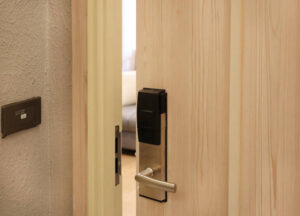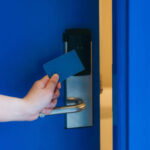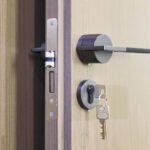Are Electronic High-Security Locks Eco-Friendly?
So, you’ve been thinking about upgrading your home security with high security door locks. But there’s a nagging question: Are these electronic marvels kind to Mother Earth?
First off, let’s chat about the obvious. Traditional locks have been around forever—like that ancient relic of a lock on your grandma’s front door. They’re simple and straightforward but come with their own set of problems. Lost keys, anyone? On the flip side, electronic high-security locks are like something out of a sci-fi movie.
These modern-day sentinels offer top-notch protection without needing physical keys. Swipe cards, keypads, biometrics—they’re all part of this new wave. Yet here’s where things get tricky: electronics mean batteries or being plugged into the grid.
Let’s talk energy consumption first. Unlike traditional locks that just sit there doing nothing until you turn them (lazy bums), electronic ones need power 24/7 for features like remote access and constant monitoring. That can add up over time! Imagine leaving your lights on all day; it’s kinda like that but less glaringly obvious.
Now onto materials—most traditional locks are made from metal which is pretty recyclable if disposed of properly (though who actually recycles old locks?). Electronic versions often incorporate plastics and other non-recyclable components due to their intricate designs and functionalities.

But wait! Not everything is doom and gloom here!
Some companies have started making strides towards greener solutions in this tech-savvy space too by using rechargeable batteries instead of disposable ones which helps cut down waste significantly over time—and hey every little bit counts right?
And then there’s smart integration—the ability for these devices to connect seamlessly with other systems at home reducing overall energy usage when managed efficiently through automation settings etc., making sure lights go off automatically when no one’s around…you get my drift?
Also worth mentioning: durability plays an important role here too since higher quality products tend last longer meaning fewer replacements needed thus reducing landfill contributions overall—a win-win situation really!
Alright, let’s dive deeper into the eco-friendly aspects of electronic high-security locks.
Consider the lifecycle of these gadgets. Sure, they require energy and materials to produce, but if they’re built to last longer than traditional locks, that’s fewer resources used in the long run. Plus, many manufacturers are now designing their products with sustainability in mind—using recycled materials and ensuring components can be easily disassembled for recycling at end-of-life.
Now let’s not forget about smart home integration. These high-tech locks often come with features like geofencing and remote access which can actually help reduce your overall carbon footprint. Imagine this: you leave home in a rush (as usual), but instead of fretting over whether you locked up or left lights on, your smart lock system takes care of it all automatically! This kind of automation ensures no unnecessary energy is wasted while providing peace of mind.
Then there’s the convenience factor—which indirectly contributes to being green too! Think about all those times you’ve had keys cut because someone lost theirs again (looking at you kids). With electronic systems using codes or biometrics instead—you’re cutting down on metal waste from duplicated keys alone!
Lastly—and here comes my favorite part—the future potential! As technology advances further who knows what innovative solutions might emerge? Solar-powered options perhaps? Or even more efficient battery technologies making these devices greener than ever before?
Green Locks: The Future of High-Security Door Locks
Imagine walking up to your front door, knowing that the high security door locks keeping you safe are also kind to Mother Earth. Sounds like a win-win, right? Let’s dive into how sustainable materials are shaking things up in the lock industry.
You know what’s crazy? A few years ago, if someone told me they were making eco-friendly locks, I’d probably laugh it off. But here we are! Companies have started using recycled metals and biodegradable plastics for their products. It’s not just about being green; these materials can be incredibly durable too.
Ever heard of bioplastics? They’re made from renewable sources like corn starch or sugarcane. These aren’t your flimsy grocery bags; we’re talking sturdy stuff that can stand up to some serious tampering attempts. Imagine a burglar trying to break in and thinking, “What is this sorcery?” It’s like turning your home security into an environmental statement.
But let’s not forget about metal – the backbone of any good lock system. Recycled aluminum and steel are becoming more common in manufacturing processes now. Think about all those old soda cans getting a second life as part of your front door’s defense mechanism! Plus, using recycled metals reduces mining activities which is always a plus for our planet.
And then there’s bamboo – yes, bamboo! This fast-growing plant has found its way into everything from flooring to furniture and now even locks. Bamboo fibers combined with other materials create composite structures that are surprisingly tough yet lightweight.
Now picture this: You come home after a long day at work (or maybe after one too many drinks), fumbling with keys while balancing groceries…and BAM! Your eco-friendly lock greets you without fuss because it’s designed smartly enough not only withstand wear but make life easier for klutzes among us!
One thing people often overlook when choosing high-security options is how much energy goes into producing them traditionally versus sustainably sourced alternatives—and boy does it add up quickly over time!
Think back on all those times where simple choices could’ve saved tons worth carbon footprint—like opting LED bulbs instead incandescent ones—or better yet switching electric cars ditching gas guzzlers altogether?
It’s the same deal with locks. Choosing sustainable materials means you’re contributing to a smaller carbon footprint without sacrificing security. And let’s be real, who wouldn’t want to brag about their eco-friendly fortress at the next neighborhood BBQ?
You might wonder if these green options cost an arm and a leg. Surprisingly, they don’t break the bank! With more companies jumping on the sustainability bandwagon, prices are becoming competitive. Plus, think of it as an investment in both your safety and our planet’s future.
So next time you’re shopping for high-security door locks, give those eco-friendly choices a second glance. You’ll not only protect your home but also play a part in protecting Earth—one lock at a time.






